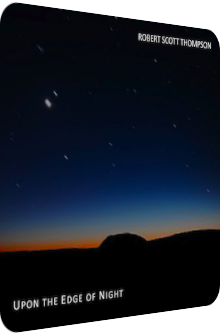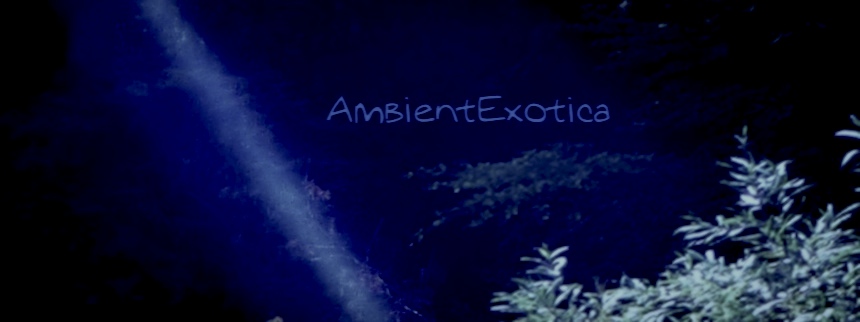
Robert Scott Thompson
Upon The Edge Of Night
2012
Upon The Edge Of Night by Californian Ambient veteran and synthesist Robert Scott Thompson is many things at once, an important thing to note if one considers its inclusion in my annual Winter Ambient Review Cycle. Its title does not feature particularly icy vocabulary, but since I am writing about music – by means of analyzing track titles as well, I have to admit – this does not prevent me from linking it to the coldest of all seasons. Released in December 2012 on the artist’s own Aucourant Records and available to purchase and fully streamable at Bandcamp, Upon The Edge Of Night is nevertheless on the edge of consideration and almost failed to be included in said cycle, but this assertion does not reflect on the quality by any means. It rather has to do with the humble reviewer’s strictness. But first things first: the album features eight compositions of the New Age-inspired kind (aka the Berlin School), and yes, all of them aurally illustrate a certain aloofness and peaceful unfolding of events, an important assessment, given that these eight pieces derive from three different – back then forthcoming – albums. Kosmische synth pads conflate with wind chimes, processed as well as transparent guitar twangs and, last but not least, a classic piano. No goblet drums, Native percussion devices or similar artifacts are included, and the lack thereof might convince readers to deny this work the New Age label. Fair enough. For the time being, I still call it that, but am also keen on its Drone-underpinned side and heliospheric spirit. And yet it comes down to this question: what endemic element, texture, source or lack thereof did almost prevent the album from being included in the Winter Ambient Review Cycle 2013? It is warmth. Rivers of warmth. Upon The Edge Of Night is a silky affair, but in its nucleus, an interplay of elemental forces takes place. In the following paragraphs, I carve out the outcome from my viewpoint and the reasons to consider this work regardless.
Strange Lines And Distances is the gateway to Robert Scott Thompson's album. Ethereal synth cherubims sing in front of a dark yet benign rivulet of droning bass runlets. Silkened electric piano globs scintillate between the interstices and cusps. Muffled cyber-oid laser sounds shoot through the thickly wadded aura of contentment. The billow-like nature allows for the afterglow of the synths and makes the track appear cold, hollow… and winterly. Within each interim fade-out phase, density and warmth decrease, and these are devices that go hand in hand on this track. Later on, only the synth choir inherits the wave-like nature, as warmth gains the upper hand via a prolonged drone stream of golden colors. In the end, however, the glassy shades and spheroidal translucency spawns bluer timbres. As the song slowly fades away, tiny protrusions of the warmer schemes try to tower above the scenery one last time, functioning as a marker of bliss despite the increasing coldness. The follow-up Glass Is The Enemy Of The Secret is a track with a great plasticity: Space-Age strings unite with concave spheres and vitreous synths. Sound, sustain, silence and their entanglement are the principal modules of this construction. Despite the faintly portentous dark matter injections, peacefulness reigns. Dun-colored but illumined by whitewashed wind chimes and fluttering sparks, Glass Is The Enemy Of The Secret is almost cheeky in the portrayal of its mysteries and surprisingly interspersed with amicable overtones.
The third track, called The Misty Place, is definitely a cavity or antrum of some sorts: vaulted and reverberated turquoise-colored cosmic marimba pads become enmeshed with comparably piercing high-rise coruscations and temple bells. Here, the mood is truly enigmatic, but lofty and aeriform enough to prevent the architecture from being mistaken for a listener-swallowing New Age grotto. Long sustain phases and an infinitesimal level of haze let the listener feel the cove's altimeter via repercussion. Up next is In the Flow That Follows, a piano arrangement with staggering keys at its core, but ameliorated by warmhearted synth cascades and galactic glitters. The track showcases the duality between fragility and voluminosity, or better still, the possibility of their harmonious coexistence. Vernal warmth and hibernal coldness coalesce in piece. And what a surprise, there is even a sort of intermission included on the album: Listening Before Radar is an ultra-short vignette that is even shy of the 90-seconds mark. Consequently, Robert Scott Thompson wastes no time and defines the precious capsule immediately. The artist envisions a place of shelter with the attributes of liquid field recordings, arcane cymbals and acidic juxtapositions of the mesmeric kind. It is comparably bustling, but retains the grace of Ambient music.
Far Side Of The Sky probably addresses the prescriptive conditions of the Berlin School best, as this is the one piece that does not hide its antediluvian complexion. Probably purposely dated and weary synth formations gyrate around another staggering and seemingly alatoric piano melody. The female cherubim is back, her synthetic voice conflating with the – actually very embraceable – square lead protuberances. These fit well with the admonitory undertone that is spawned throughout the runtime. Maybe a forewarning of the night that is yet to come? In any way, A Winter's Music, the album's seventh track, definitely justifies the inclusion in my Winter Ambient Review Cycle. A long-form piece of 16+ minutes, A Winter’s Music emanates a vertiginous amount of iciness, gales and elasticized icicles that are transformed into music. Cracking ice and Glitch-evoking pops and crackles are additional adjuvants to the perception of coldness, with the slapped guitar being the only source of bonfire-like proportions, shimmering through the night, spending warmth and comfort. The second half sports dark bass drones and starkly translucent synths. The heavy reverb increases the perception of wideness, with the title track and finale Upon The Edge Of Night being equally glacial due to its superimposed synth sinews of the euphonious kind; even euphoria is interwoven. The different textures create a curious effect: is this a warm arrangement or a cold one? Bumpy bass eruptions nurture the warmth, crickets and cyber birds squawk through the night of a late 80’s virtual reality scenery.
Robert Scott Thompson’s Upon The Edge Of Night may sit in-between many a timbre and genre-driven expectancy, but the result, while comprising of works for different albums and thus phases, still feels cohesive enough to justify its status as an album. The definite place of the prolific composer’s album is harder to pinpoint. Granted, it is part of my annual Winter Ambient Review Cycle, so it must be at least somewhat glacial, and this is exactly the case indeed. However, this is neither a work of exclusively New Age-focused patterns à la ancient cavities as found in The Misty Place or oft-considered odes to snow-covered landscapes such as A Winter’s Music, nor an exclusively nocturnal voyage as the album and title track evoke, and the reason for this is emitted by the thermal heat source that is transformed into music. Whatever this means to the respective listener, whether it is polyphonic enchantment, wondrously blurred surfaces or soothing susurrations, Upon The Edge Of Night does opaquely greet the listening subject even in the most forsaken of its aural places. There is New Age music – excellent New Age music, I might add – which features incredibly saturated and incandescent textures, magnanimous amounts of layers and helical ornaments en masse. Thankfully, and almost oddly so, Robert Scott Thompson does not succumb to these production techniques, even though he is close to the source and only one small step away. In lieu of bolstering, boosting or revving up the layer entanglement, he lets darkness in. Ain’t I a genius: Thompson lets darkness in on an album called Upon The Edge Of Night. But there is more to it than that. The backdrop of nonentity which is only illuminated by the long sustain and reverb phases, actually serves as a cold counterpart to the warm mellowness which graces the opener and traverses through all subsequent compositions. The luminary hence makes use of warmth as an antagonistic force, and at least in winterly Ambient works, warmth can be considered de trop. But it makes things all the more interesting. Shuttling between New Age, vestiges of Drone, and the cosmos of Space Ambient, Upon The Edge Of Night worships darkness, coldness and quieter unfoldings, but never dismisses the energy of benignancy.
Further listening and reading:
- Upon The Edge of Night is available to purchase and stream at Bandcamp.
- Robert Scott Thompson is on Twitter: @RST_PhD.
Ambient Review 293: Robert Scott Thompson – Upon The Edge Of Night (2013). Originally published on Dec. 11, 2013 at AmbientExotica.com.
